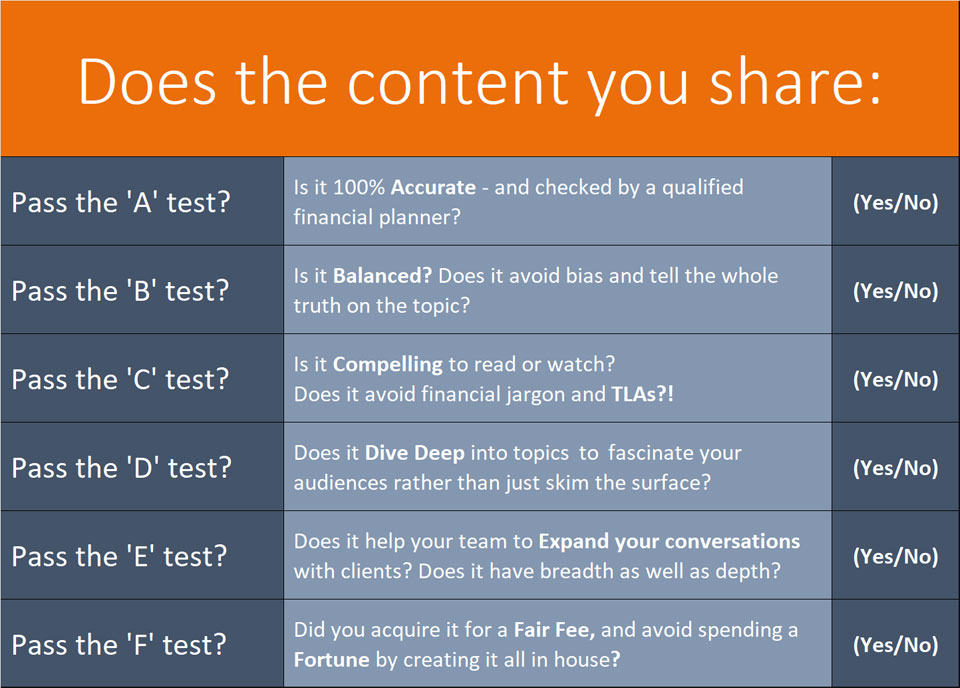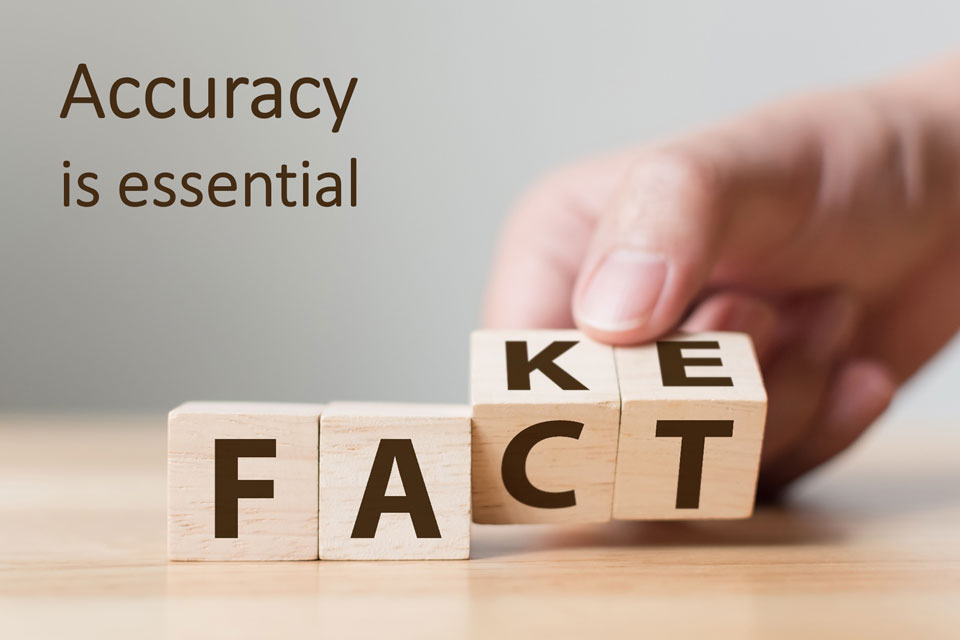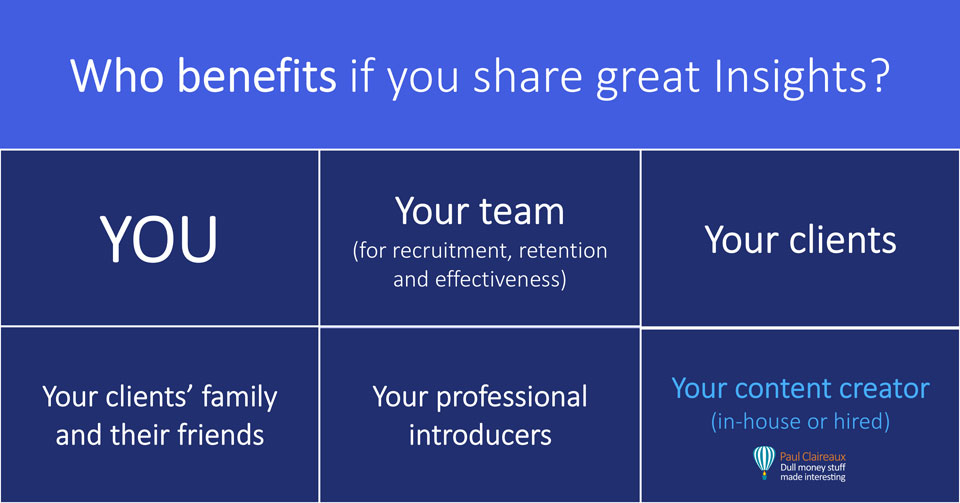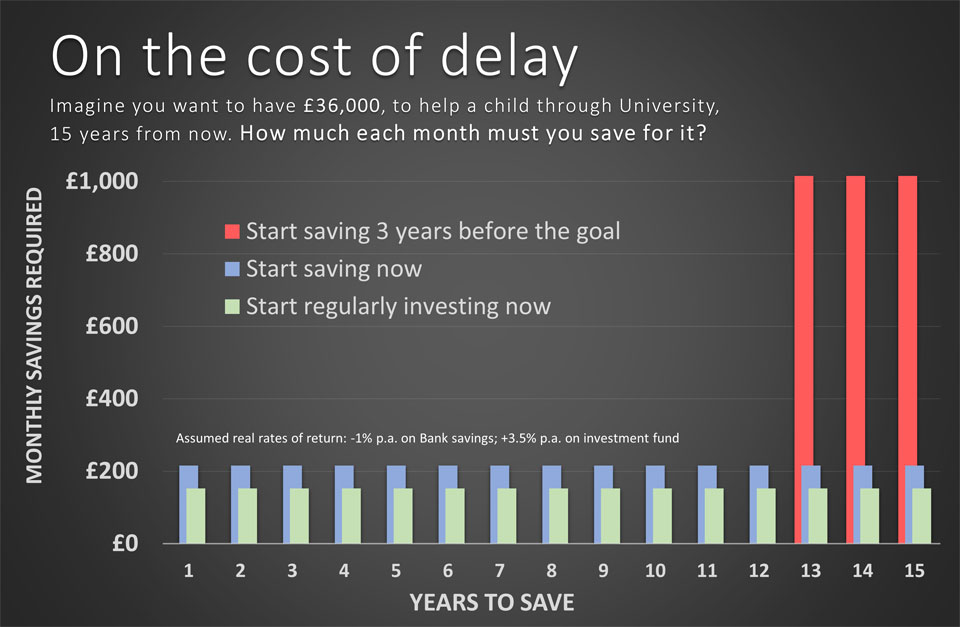Six ways to rate a content creator (Part 1)
Is their content Accurate, Balanced and Compelling?

This (10-minute read) is one of three Insights for owners of Financial Planning/Advice firms, covering six tests for rating the services of content creators or suppliers.
What are these 6 tests?
 In this Insight, I’ll unpack the first three of these six tests and then cover the other three in the following two Insights.
In this Insight, I’ll unpack the first three of these six tests and then cover the other three in the following two Insights.
And, of course, I answer all six questions as they relate to my services, along the way.
So, this is a deep-dive series into choosing a great content creation partner.
It might simply confirm you’re on the right track with your consumer-facing content and getting great value for money from your team or any suppliers you use.
Alternatively these Insights might give you ideas for boosting your client engagement and saving tens of thousands of pounds on your marketing over time.
If you’d rather talk than read about these tests, let’s do that. You can book a meeting here.
I’m keen to help you find a great content creator – regardless of who it turns out to be.
Can I assume you know the benefits of educational marketing?
I know assumptions are dangerous.
As ‘Felix’ in the classic comedy series ‘The Odd Couple’, said:
If I ASSUME, I make an ASS out of U and ME!
However, I want to focus on supplier selection here, so I will assume that:
- You plan to work with a Financial Education content supplier, either for the first time or to replace (or work alongside) one you have today.
- You’re familiar with the 25 benefits of Education-First marketing, as outlined in this other post.
And I’ll assume you’re aware of the eye-watering costs of creating all your content in-house without any outside help.
If not, the key numbers are shown in this chart.
For the assumptions behind this chart, email hello@paulclaireaux.com with the title, ‘Chart Assumptions’.
They’re based on hundreds of thousands of words’ worth of content creation experience.
Who inspects the content on your website today?
If you have a skilled website designer, your site will not only look good but also function well.
If not, you really must fix that – because your website is the shop window for your business.
You may need to fix many things, but if you focus on customer experience, you won’t go far wrong.
For instance, some advice firms still share Newsletters as PDF documents, despite the fact that they’re often impossible to read on mobile devices and provide no data about client engagement.
However, while your website’s look, functionality and speed are all important, what really matters is:
‘What you say – and how you say it’
It’s the Insights you share which make or break your reputation as a trustworthy place for consumers (and others) to visit.
Your website visitors will share *great* content with their family and friends.
Your professional connections will share *valuable* content with their clients.
So, it’s essential to check the quality of the content on your website.
Does your content need a SCAN?
 Have you ever asked for an ‘Independent’ assessment of how your website (esp. your consumer-facing educational content) looks and feels?
Have you ever asked for an ‘Independent’ assessment of how your website (esp. your consumer-facing educational content) looks and feels?
- Does its structure help your visitors find what they want?
- Are your signature Insights a compelling read, and do they all pass the A to F tests below?
- Indeed, do you yet offer any (deep dive) signature Insights to help people see the value of your advice?
- Does your writing style help people understand the core concepts of financial planning?
- Do you know how your content scores against six key elements of writing style?
- Do you offer high-impact images to bring all the key concepts to life?
It’s extremely hard to create Accurate and Balanced consumer-facing insights on money (and money psychology) questions.
Yet, all that work (or content cost) is wasted if no one engages with the ideas you share.
And most people do ignore dull or technical content, as we’ll see later.
So, if your content is boring, you need to up your game – fast!
How can you know if your content is engaging or dull?
If you use a reputable newsletter platform (such as Mailchimp) and see high open and click-through rates, that could be a good sign if your subscribers are all clients or potential clients.
Please note that if you have a large number of industry contacts or competitors on your mailing list, these metrics may not accurately reflect how engaging or relevant your content is to potential clients.
You could easily overestimate the value of your content to consumers.
Either way, you could ask me for a “Structure and Content Assessment Note” (a SCAN!) of your website.
Just e-mail me at hello@paulclaireaux.com (with the word ‘SCAN’ in the title) to discuss this service.
I work in a similar way to you.
I examine your current content and suggest improvements.
And this SCAN might help you remove risks in your business and/or boost your reputation with clients and professional connections.
Now, that’s enough about checking your website.
Shall we get back to our checklist of content suppliers?
OK.
Now, in an ideal world, you’ll test a supplier before you start using them.
But if you already have a content supplier, start asking these questions now and on an ongoing basis.
After all, your business reputation depends on the quality of the Insights you share. And, with competition and regulation intensifying, you must set a high-quality bar.
So, let’s crack on with this checklist.
And, as I’m using an A to F mnemonic for this checklist, we’ll start with the letter ‘A’
‘A’ asks: Is the content Accurate?
 You know the well-being of your clients rests on the integrity of your (or your team’s) advice.
You know the well-being of your clients rests on the integrity of your (or your team’s) advice.
And your (generic) educational content may be the first guidance your potential clients see.
So this content must be 100% Accurate. If it’s not, you’re putting your reputation at risk.
Any flaws or biases in those messages could undermine trust in your services among clients, their family and friends, and other prospects.
Remember also that your Legal and Accountancy connections are more likely (than clients) to spot flaws in any content shared.
And, of course, you face regulatory risks if you share misleading ideas with consumers.
In short, getting your content right is a high-stakes game.
‘A’ is for Accuracy, and must surely be your first supplier rating factor.
‘B’ asks: Is the content balanced?
Half a truth is still a whole lie.
Benjamin Franklin, 1735.
Offering Accurate content is a great start, but ‘Understanding’ under the Consumer Duty requires us to tell the truth and the whole truth.
So, obviously, you don’t want content that tilts messages to suggest a particular course of action.
If you do, I’m the wrong guy for you!
That sort of content is a sales pitch or financial promotion, and has no place in an educational library.
I know you can only make recommendations after you know your customer.
I’ve passed advanced financial planning exams, and I’ve worked as a wealth manager.
So, I create content that educates and informs.
It does not pitch or sell any financial product or investment idea.
Telling the whole truth is essential in matters of money and investing. The client’s financial security (or that of their loved ones) is at risk if we get this wrong.
So it saddens (and maddens) me, as I’m sure it does you, to see content shared with consumers that’s either inaccurate or imbalanced.
What problems do I see with content?
Sometimes it’s ‘just’ a few typos, but the errors can be much worse.
Colourful but misleading charts in guides are common.
You need someone with design skills to create colourful guides, of course. But you must have someone with a sound knowledge of financial planning (and how to present numbers) overseeing this work.
One particular content provider regularly shares beautifully designed but grossly misleading charts.
So, there are still imbalanced and misleading ideas shared with consumers.
In one case, I persuaded the senior management of one of the world’s largest fund managers to remove misleading content from their otherwise excellent adviser guide.
In fairness, the managers fully accepted the error when I pointed it out – and said they would start paying more attention to what their marketing people were doing!
However, this was not an isolated case, and that misleading idea is still shared by other fund managers and support service providers.
I’m working on those as well, but I’m unhappy about doing this unpaid work for the FCA!
In any case, I urge you to avoid falling into that trap and take extra care to check the accuracy and balance of the content you share.
And, if you’d like an independent and qualified second opinion on your content, email hello@paulclaireaux.com with “SCAN” in the subject line.
This valuable service could boost your business reputation.
How can you build (or maintain) the trust you deserve?
My work life mission these days is to help you become (or maintain your position as) a Trustworthy ‘go-to place’ for consumers to find answers to vital money questions.
 The evidence is clear: People’s initial perception of us comes first from our warmth (our intentions), then from our competence.
The evidence is clear: People’s initial perception of us comes first from our warmth (our intentions), then from our competence.
(Note that I’ve added reliability as a multiplier in that equation because, as we all know, reliability is what really counts for building trust once the client is engaged)
What does this equation mean for your content strategy?
It means that one poor-quality (cold or misleading) Insight can undermine your prospect’s perception of your intentions and competence.
And that’s what destroys trust.
Therefore, it’s essential to demonstrate expertise, experience, and authority.
And, unsurprisingly, Google also knows these things matter.
‘C’ asks: Is the content really compelling?
 So, offering content that’s accurate and balanced is essential, but that alone only gives you an entry ticket to the Content Club.
So, offering content that’s accurate and balanced is essential, but that alone only gives you an entry ticket to the Content Club.
Valuable content must grab people’s attention and trigger emotional responses.
It must resonate and detonate thoughts of action with your audiences.
And for this, every sentence must be crafted and refined – by a creative human mind!
You cannot leave content creation to an AI Robot – clever though they are.
Nor do you want a supplier who churns out content for the sake of it or who thinks the goal is to hit a particular word count.
That gives you dry, repetitive and padded content.
And you really don’t want that.
 Like a great movie, you want your content to provoke different emotional responses at various places.
Like a great movie, you want your content to provoke different emotional responses at various places.
This type of content takes time to create.
So, if you opt for a custom-made content service, don’t pay by the word count.
Pay for time spent to encourage the creation of compelling works.
The best writers charge this way – and will quote you a price cap on their work to keep you on budget.
Choose an experienced content creator, and they might even offer you some low-cost licensed versions of their lifetime-best works.
You can then keep your costs down by mixing these standard works with any bespoke Insights you offer.
Are you wasting your money on content?
 As I’ve said, you will waste a significant amount of effort (or cost) if your content fails to engage your audience.
As I’ve said, you will waste a significant amount of effort (or cost) if your content fails to engage your audience.
And, the evidence is that most people (expert or otherwise) ignore boring content.
Research from Nielsen (the ‘User Experience’ experts) found that even highly educated professionals (scientists, medical experts, technologists) favour clear and scannable information.
Others, who led the work to redesign GOV.UK discovered that:
“the more educated the person and the more specialist their knowledge, the greater their preference for plain English”
Have you noticed how the .gov website is now much more understandable?
So, we have all the evidence we need.
Engaging, trust-building content requires the right words, sentences and writing style.
It’s not about choosing videos over text-based posts.
And I have no axe to grind on this because I also script videos.
That’s why I write in a conversational style.
I don’t think you should pay twice for the same message in different formats.
You need compelling Insights to help your firm stand out in the sea of financial services grey.
Offer those and you will attract, engage and retain more clients.
Very few prospective clients stay on websites for long unless they’re engaged.
And once they’re bored (or feel like they’re being misled), there’s almost no chance of them returning to your website – or recommending it to their friends or family.
Sorry, but that’s just how this goes.
The risks are high if your content is inaccurate, imbalanced or boring. 
So look hard at it against those ABC tests.
Or hire a good content creator to SCAN your website on those and the rest of these tests.
Ready for the next test?
I hope these ABC tests have got you thinking about how to choose a great content creator.
Click here for the next test when you’re ready for that
Want to stay in touch?
To stay up to date with my services and the Insights I offer, sign up for my Educators Newsletter here.
Or, to talk about any of my services, book a meeting here.
And thanks for dropping in.







Discuss this article